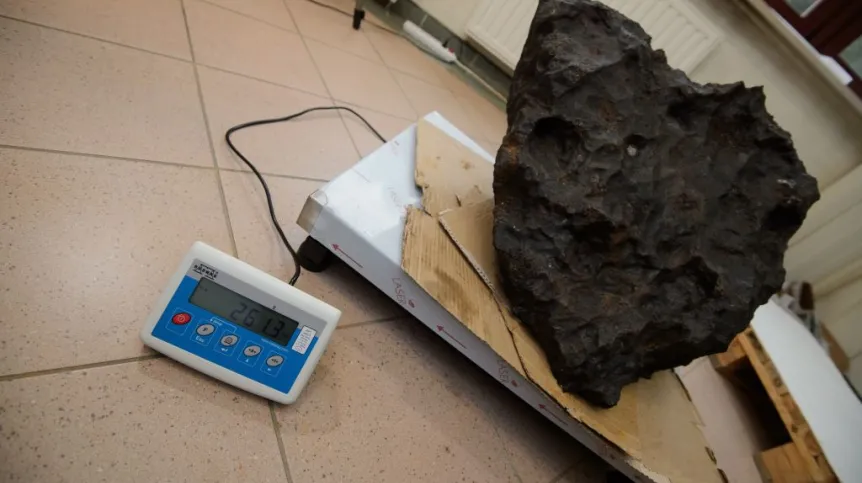
Poland\'s largest meteorite, found a month ago in Poznań Morasko, weighs 261 kg. The find was officially weighed after several days of clearing the detritus at the Faculty of Geography and Geology, Adam Mickiewicz University.
The meteorite was excavated on October 8 by professional meteorite hunters from Opole: Łukasz Smuła and Magdalena Skirzewska. During the mechanical cleaning of the meteorite, about 18 kg of detritus fell off.
"We are proud to have managed to clean it up, now starting next Monday, the meteorite will be shown at the Earth Museum of our Faculty" - said the head of the research team Prof. Andrzej Muszyński.
Fusion crust is visible on the cleaned meteorite. "With this, we know which part of it hit the atmosphere, which is why we refer to it as an oriented meteorite. The meteorite surface contains troilite-graphite nodules, which allow us to examine the processes of formation of planetary matter" - said Prof. Muszyński.
During the meteorite cleaning, scientists have found rare minerals, which together with the detritus will be examined by scientists. Members of the Polish Meteorite Society will be among the first to examine the meteorite.
The meteorite has a conical shape with dimensions: 50 cm height, 40 cm width and 71 cm length, circumference at its widest point - 2 meters. It is a coarse IAB octahedrite, consisting of 93 percent iron, 6 percent nickel.
The search for the meteorite started on September 16, on October 8 the meteorite was extracted.
"We have been working in Morasko as professional hunters for 10 years. This time, we surveyed the area with Frame Impulse Detector using for deep searches, focusing only on large objects, and we succeeded. It is not only the culmination of our work, but also an amazing discovery, not only for hunters but for science"- Łukasz Smuła told PAP.
He estimated the market value of the meteorite at about PLN 1.2 million, but the greatest value of this find will be scientific publications.
"Through study of our meteorites, we can take part in the scientific debate about the origins of the universe. We know that the Earth\'s core is made of iron, but we cannot study it, and here we have a visitor from outer space, which has a similar structure and can be analysed. It can be very interesting also for laymen" - added Muszyński.
Morasko Meteorite Reserve on the slope of Morasko Hill documents the location of the largest iron meteorite rain in Europe. It is also one of the few known places in the world where there are both meteorites and impact craters caused by the fall.
Research in this area continues since the mid-twentieth century. Recently, in the years 1997-2012, the work has been conducted by researchers from the Institute of Geology of Adam Mickiewicz University Prof. Wojciech Stankowski and Prof. Andrzej Muszyński. They proved the impact type of meteorite craters and found many new specimens of meteorites. Many meteorites have been found in this area, , the official count is over 1.5 tonnes of extraterrestrial matter.
PAP - Science and Scholarship in Poland
kpr/ ls/ mag/ mrt/
tr. RL
Fundacja PAP zezwala na bezpłatny przedruk artykułów z Serwisu Nauka w Polsce pod warunkiem mailowego poinformowania nas raz w miesiącu o fakcie korzystania z serwisu oraz podania źródła artykułu. W portalach i serwisach internetowych prosimy o zamieszczenie podlinkowanego adresu: Źródło: naukawpolsce.pl, a w czasopismach adnotacji: Źródło: Serwis Nauka w Polsce - naukawpolsce.pl. Powyższe zezwolenie nie dotyczy: informacji z kategorii "Świat" oraz wszelkich fotografii i materiałów wideo.













